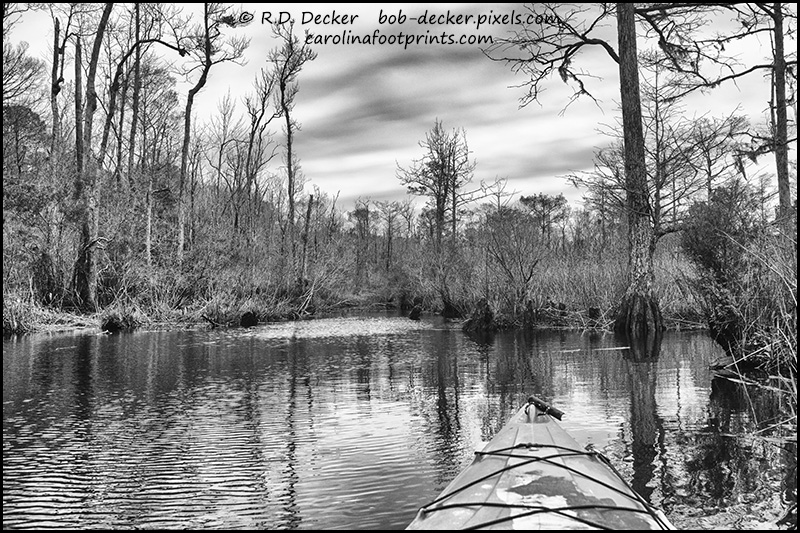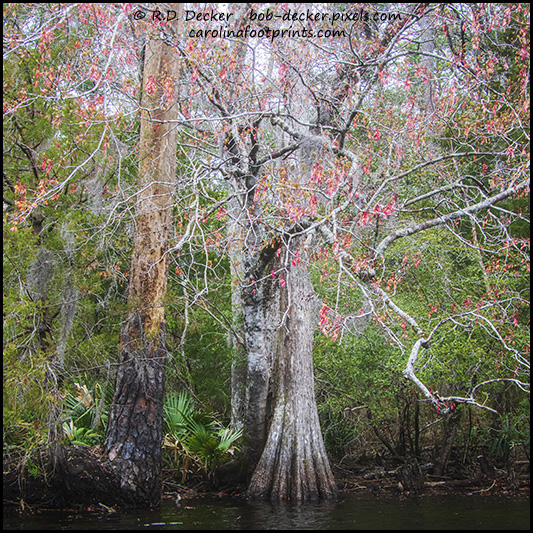There was a time that I went kayaking two or three times a week. The last couple of year I had so much going on that I didn’t even put my boat in the water. That’s kind of a sad commentary for someone that wrote a book on using kayaks as a photography platform! Yesterday morning I broke that dry spell and went for a paddle along Cahooque Creek in Craven County, North Carolina. I’m really looking forward to some more upcoming adventures. Below are a couple photos from the outing. Let me know what you think.


6 Comments
I bought a pack canoe last year as I was struggling getting a real canoe on the roof of the car. Just 16 pounds, so perfect for me. I’ve not really felt confident to take my main camera out for a paddle yet! By the way, what resolution are the images above? The second one looks a bit pixelated.
Steve, when I was younger I was really into canoes and avoided kayaks. In my mind they were unstable, wobblely little vessels. Once I experienced a kayak for the first time I never looked back. Twin blade paddle technique is much simpler than dealing with a single blade paddle. A sit-in kayak provides a good deal of protection from the elements. Modern kayaks, and particular “recreational” class boats are anything by tipsy. Keep your camera in a dry bag when not in use. Ideally have that drybag leased or bungyed in the boat in case of a capsize. My old stand-by lens for kayak photography was a Sigman 50-500 mm. I wore out two over the years. I’m now using a 150-600 mm. Great lens but leaves me without anything on the short side. On the recent trip I also carried a wide-angle zoom. I’m not wild about changing lenses while floating. I think on the next outing I’ll try two separate cameras, each in its own drybag.
Image resolution is 100 at 533 x 533. I ran an action on it (I rarely do) called soft and intense. That may be giving you the impression of it being pixelated. Check out the full resolution view at https://bob-decker.pixels.com/featured/a-splash-of-color-in-cahooque-swamp-north-carolina-bob-decker.html and see what you think.
I love your vantage point from the kayak – it’s always intrigued me! The ability to get so many more interesting shots than if you’re standing on the shoreline is excellent. The first image is my favorite – seeing the kayak out in front – and I love it in black and white.
Do you have a recommendation for a dry bag? Not that I’m looking to be out on the water, but just to protect my gear in general. I have 2 different sling bags but I despise one of them and am looking for an alternate.
Thanks much. The beauty of photography out of a kayak is the low, water-level POV. Updating and revising my ebook on kayak photography is on my to do list.
If you want a dry bag for uses other than in a kayak or canoe really any bag should work. The ones found in the Walmart sporting good department are sufficient. They’re probably even okay for kayak use. NRS and REI are basically the national “go to” venders for kayaking gear. You might check them out if you’re looking for something a bit more substantial.
For hiking and walkabouts a lot of folks use backpacks, and they’re fine for that purpose. I’m just not a fan of the need to take off the pack and open it to make gear changes, etc. The last year or two I’ve been using a Photographer’s or Travel vest to carry extra lenses and accessories in the field. Access is quick and weight distribution is pretty even with them. On a typical walk I’ll have my camera with a long lens on a black-rapid strap… if I’m carrying two cameras they have a black-rapid harness for that too! Extra lenses, filters and such will be in vest pockets. I’ll have my carbon fiber tripod up on my shoulder or in my arms. It works for me. For longer excursions, or if I need a second tripod to accommodate shooting video while making stills, I use a photography backpack with a built in system to carry a tripod.
Hope this answered your questions.
Great post, I love the cypress tree and feel the need to get a kayak, i need a cheap light one, that I could lift. Don’t have a lot of strength. I was looking at blow ups, but takes a look of time to pump it up. Any recommendations on a kayak?
I’d recommend a recreational class, sit-in kayak. At least 10 feet in length, preferably 12 feet. These are very stable boats with a roomy cockpit. I have a Perception Prodigy and a Field & Stream Eagle Run. Wilderness systems also offers great recreational level yaks in their Pamlico series. I’ve heard some decent reports on the kayaks that Walmart sells, though have no experience with them personally. Check Craigslist and eBay Marketplace for used boats.